
The Northwest Railway Museum (NRM) is a railroad museum in Snoqualmie, King County, Washington. It incorporates a heritage railway, historic depot, exhibit hall, library, and collection care center, and serves more than 130,000 visitors per year.
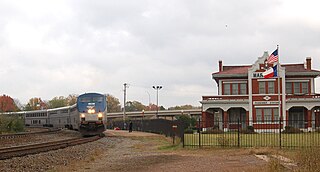
Marshall station is a railroad station in Marshall, Texas. It is served by Amtrak, the national railroad passenger system, which operates the Texas Eagle through Marshall each day, with service north to Chicago and west-southwest to Dallas, San Antonio and Los Angeles. The station also houses the Texas and Pacific Railway Depot & Museum.

The Bessemer Hall of History is a museum located in, and devoted to the history of, the city of Bessemer, Alabama.

The Fullerton Transportation Center is a passenger rail and bus station located in Fullerton, California, United States.
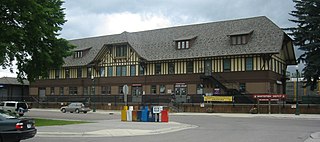
Whitefish station is a stop on Amtrak's Empire Builder in Whitefish, Montana. In addition to the Empire Builder, a once-daily Greyhound Lines bus service also links the station to Kalispell and Missoula. A car rental agency operates a window within the station. The station and parking lot are owned by the Stumptown Historical Society. BNSF Railway leases office space on the upper floors of the station and owns the platform and track.

Winona station, formerly known as the Chicago. Milwaukee & St. Paul Railway Station, is a historic train station in Winona, Minnesota, United States. It is served by Amtrak's daily Empire Builder service. It was originally built in 1888 by the Chicago, Milwaukee, St. Paul and Pacific Railroad, known later as the Milwaukee Road. A former Milwaukee Road freight house also exists here.

Princeton station in Princeton, Minnesota, United States, is a former passenger and freight depot on the Great Northern Railway. The building is a combination of Queen Anne and Jacobean architectural styles, built of local brick with sandstone trim. It was listed on the National Register of Historic Places in 1977 as the Great Northern Depot.

Aitkin station in Aitkin, Minnesota, United States, is a brick passenger depot built on the Northern Pacific Railway mainline, opening on January 26, 1916. The rail line is now part of the BNSF Railway. The depot symbolizes the importance of the railroad in Aitkin's growth and development.
The Great Northern Depot or Great Northern Passenger Depot may refer to:

The St. Louis County Depot is a historic railroad station in Duluth, Minnesota, United States. It was built as a union station in 1892, serving seven railroads at its peak. Rail service ceased in 1969 and the building was threatened with demolition until it reopened in 1973 as St. Louis County Heritage & Arts Center . Train service also resumed from 1974 to 1985, by Amtrak.

The Great Northern Depot in Skykomish, Washington, United States, is a former train station and local history museum. It was built by the Great Northern Railway in 1894 to serve the town of Skykomish, which had been founded as a division point on the railroad. Its original location was on the south side of the tracks at 5th Street. In 1922, the depot was moved to its present location on the north side of the tracks at 4th Street.

Mayville is a historic train station located at Mayville in Chautauqua County, New York. It was constructed in 1925, for the Pennsylvania Railroad and is a 1+1⁄2-story, brick structure with an overhanging hipped roof. The building measures 117 by 29 feet. The station had were Pennsylvania Railroad trains on a route north to Dunkirk and then to Buffalo. To the south, the routed went to Corry and Oil City and then to Pittsburgh. From the station, travelers to resorts along Chautauqua Lake made connections to interurbans and large fleets of steamboats. The Chautauqua Traction Company served the communities on the western side of the lake; and the Jamestown, Westfield and Northwestern Railroad served the eastern side of the lake.

The Fargo station is a former railway station in Fargo, North Dakota. Built in 1898, it was listed on the National Register of Historic Places in 1975 as the Northern Pacific Railway Depot.

Issaquah station, also known as Issaquah Depot or the Seattle, Lake Shore and Eastern Railway Depot, is a former railway station located in Issaquah, Washington, listed on the National Register of Historic Places. It was built in 1889 as a passenger station and freight warehouse for the Seattle, Lake Shore and Eastern Railway (SLS&E), serving what was then known as Gilman, Washington. The town was renamed Issaquah around the turn of the century. Only a few years after the depot's opening, in the 1890s, the SLS&E was taken over by the Northern Pacific Railway.
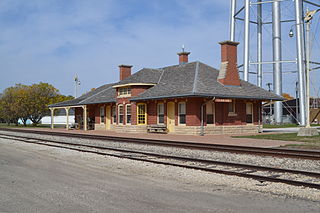
Burlington, Cedar Rapids and Northern Railroad Passenger Station, also known as Rock Island Railroad Depot and the Rock Island Depot Railroad Museum, is a historic building located in Clarion, Iowa, United States. The station was built in 1898 by contractor A. H. Connor & Company of Cedar Rapids, Iowa for the Burlington, Cedar Rapids and Northern Railroad (BCR&N). Clarion also had a Chicago Great Western Railway depot, no longer extant. At one time there were 14 trains that served the city. In 1903 the Chicago, Rock Island and Pacific Railway acquired the BCR&N, and this depot served that railroad. The single story, Romanesque Revival, brick structure measures 26 by 88.5 feet. It was added to the National Register of Historic Places in 1988.

Great Overland Station, listed on the National Register of Historic Places as Union Pacific Railroad Passenger Depot, is a museum and former railroad station in Topeka, Kansas, United States. The station was built from 1925 to 27 and designed by Gilbert Stanley Underwood, whose firm designed over 20 Union Pacific Railroad stations from 1924 to 1931. The station's Free Classical Revival design uses terra cotta extensively and features a center pavilion with two increasingly smaller pavilions on either side. Passenger service to the station began in January 1927; almost 20,000 people attended the station's grand opening, and the new station was considered "one of the largest and finest stations west of the Missouri River". In the later years of its train station life, it also hosted the passenger trains of the Chicago, Rock Island and Pacific Railroad. The Atchison, Topeka and Santa Fe Railway 'Santa Fe' had its trains stop at its own Topeka station.
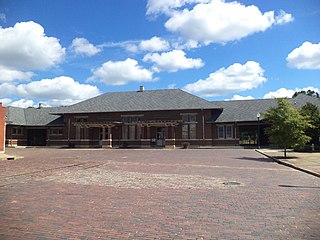
Albany Railroad Depot Historic District is located at the 100 block of West Roosevelt Avenue in Albany, Georgia, United States, and is governed by the Thronateeska Heritage Center, a 501(c)3 not-for-profit organization incorporated in 1974 for the purpose of historic preservation and science education in Southwest Georgia. The Heritage Plaza includes the Tift Warehouse, the Union Station depot, the Railway Express Agency building and Albany's last remaining brick street and is listed in the National Register of Historic Places (NRHP).

The Little Falls and Dakota Depot, also called the Starbuck Depot, is a former railway station in Starbuck, Minnesota. It was in service from 1882 to 1982. The depot was listed on the National Register of Historic Places in 2006 for having local significance under the themes of commerce, exploration/settlement, and transportation. It was nominated for its associations with the expansion of rail lines and European settlement into the region, and the growth of Starbuck as an agricultural trade center. The depot was restored beginning in 1986 by the non-profit Starbuck Depot Society, and it is now part of an open-air museum.

The Chicago Great Western Railroad-Waterloo Freight Depot is a historic building located in Waterloo, Iowa, United States. In 1887 the Chicago, St. Paul & Kansas City Railroad (CSP&KC) was the third system to enter the city, after the Illinois Central (1870) and the Burlington, Cedar Rapids and Northern Railway (1876). The CSP&KC was the first of the three to put its depots in the downtown area. Initially it built two depots in Waterloo, one on the west side of the Cedar River and one on the east side. By 1892 it had built separate passenger and freight depots along East Sixth Street. That was the same year that the CSP&KC became known as the Chicago Great Western Railroad. In 1903 the railroad built new passenger and freight depots a block south, moving them closer to the city's wholesale houses. The two-story concrete block freight depot was built on a rough limestone foundation. It features round arch freight doors and a simple wood cornice. The concrete block addition on the southeast side replaced a frame gabled structure, but its construction date is unknown. The old brick passenger depot was torn down in 1973, and the freight depot was listed on the National Register of Historic Places in 1997. In 2001 the building, which is owned by the City of Waterloo, was leased to the University of Northern Iowa for its Center for Urban Education (UNI-CUE).
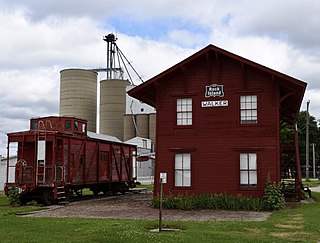
Walker Station is a historic building located in Walker, Iowa, United States. The two-story frame building with bracketed eaves was completed in 1873 along the Burlington, Cedar Rapids, and Minnesota Railway tracks. The depot also served its successor railroads: the Burlington, Cedar Rapids and Northern, and the Chicago, Rock Island and Pacific. Typical of many railroad towns in the Midwest, this is the first building that was built here and the town grew up around it. It is an example of a combination depot that was used for both passenger and freight usage in smaller communities. Because it has a ground level brick platform, service here was primary passenger and light freight service. A higher level of freight service would have required a raised platform.






















